Agritourism, the business of engaging, entertaining and educating visitors on farms and in other agricultural settings, is a growing trend. According to the experts, the global agritourism market size reached 65.6 billion USD in 2023 and is expected to grow by 11.45% over the next 8 years. This significant growth is attributed to the increasing demand for immersive travel experiences and the rising awareness of local food sources. Agritourism takes many forms ranging from extended-stay dude ranch experiences to brief on-site informational farm tours. Other examples include culinary events such as farm-to-table meals and cooking demonstrations; amusements such as hay rides, petting zoos and corn mazes; U-pick operations for berries, fruit, vegetables, flowers or other produce; workshops and immersive activities; and on-site markets or shops selling farm-grown and themed products.
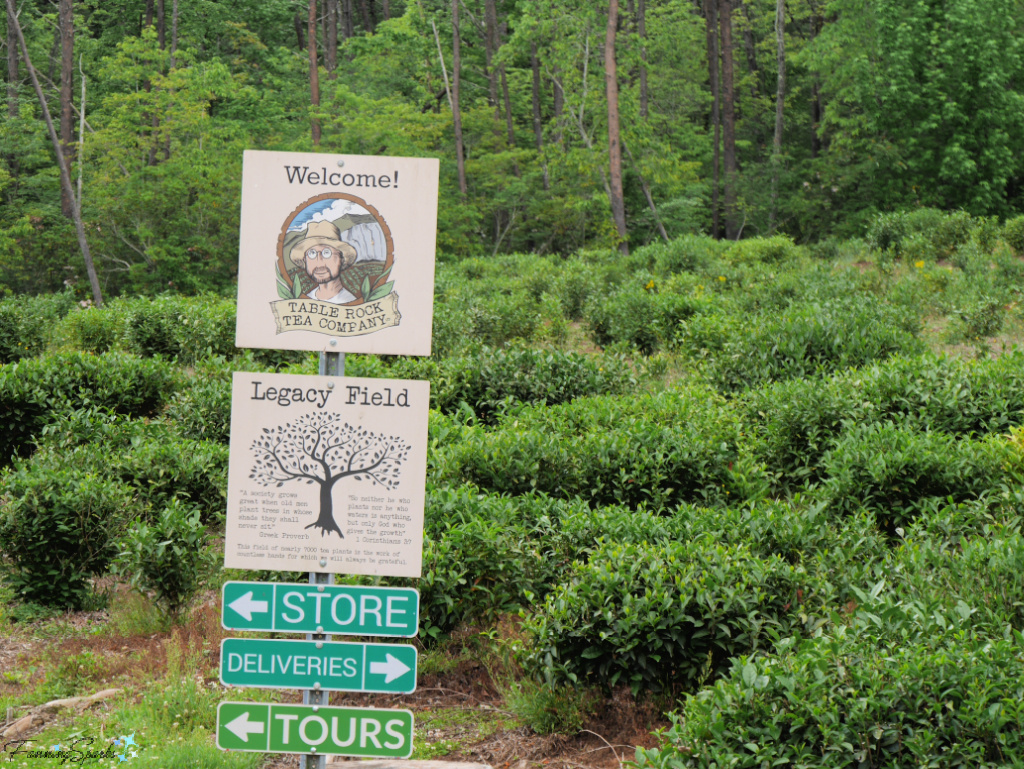 The annual Ag + Art Tour in South Carolina is a great example of a successful agritourism event. Nearly every weekend in May and June, the farms and markets of a particular county (or counties) in the state are showcased on social media. Local artisans also gather at the designated locations to demonstrate their craft and sell their work. It’s a free, self-guided tour—guests are invited to visit and tour the locations that interest them. “The tour is the largest free farm and art tour in the nation [USA] with over 85,000 visitors participating since 2012.” reports the Ag and Art Tour website.
The annual Ag + Art Tour in South Carolina is a great example of a successful agritourism event. Nearly every weekend in May and June, the farms and markets of a particular county (or counties) in the state are showcased on social media. Local artisans also gather at the designated locations to demonstrate their craft and sell their work. It’s a free, self-guided tour—guests are invited to visit and tour the locations that interest them. “The tour is the largest free farm and art tour in the nation [USA] with over 85,000 visitors participating since 2012.” reports the Ag and Art Tour website.
I recently had the opportunity to participate in the Ag + Art Tour in Pickens County, South Carolina where I visited several farms and artistic venues. My favorite stops included three farm visits: Table Rock Tea Company, Mushroom Mountain and The Happy Berry. I’d like to share a few highlights from these visits in today’s blog post. Shown below are the locations I visited on a map of Upstate (northwest) South Carolina.
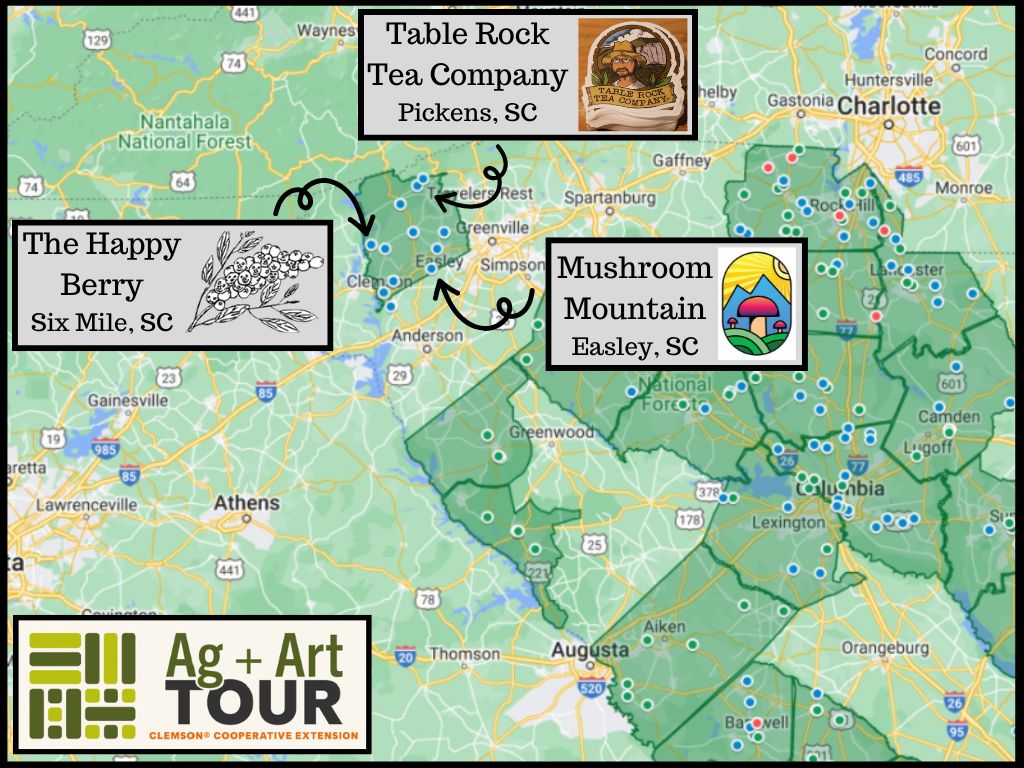 Table Rock Tea Company
Table Rock Tea Company
As you might guess from the name, the Table Rock Tea Company specializes in tea. What you might not guess is they are one of less than a dozen tea growers on mainland USA who cultivate, harvest, produce and sell their own tea. They offer an exclusive selection of teas including WinterLeaf (cold-harvest green tea), Carolina Lapsang (hickory and applewood smoked black tea) and Westminster (green tea, natural apricot extract, sage). Each variety has its own intriguing story illustrated with charming artwork.
 The story behind Marathon, their Kenyan black tea, for instance, is this: “In the early 2000’s, our founders started Hydromissions International, an outreach providing clean water to hundreds of thousands of people around the world. While on a water well project in northern Kenya, they stayed in the villages with tea farmers, and this is where they fell in love with tea. Over a decade later, when TRTCo launched, we wanted to carry ‘the tea that started it all.’ Same farmers, same fields, same factory. … We named the tea Marathon as a tip of the hat to our Kenyan friends, who are among the world’s most elite runners. It’s also naturally high in caffeine to ‘Put Some Pep in Your Step.’ Jen [Jennifer Lorch co-founder and CFO] is a runner, and since Steve [Steve Lorch co-founder and CEO] is already on the logo, it was only fitting that she would be on the first box, along with her faithful running companion, Jazzy.”
The story behind Marathon, their Kenyan black tea, for instance, is this: “In the early 2000’s, our founders started Hydromissions International, an outreach providing clean water to hundreds of thousands of people around the world. While on a water well project in northern Kenya, they stayed in the villages with tea farmers, and this is where they fell in love with tea. Over a decade later, when TRTCo launched, we wanted to carry ‘the tea that started it all.’ Same farmers, same fields, same factory. … We named the tea Marathon as a tip of the hat to our Kenyan friends, who are among the world’s most elite runners. It’s also naturally high in caffeine to ‘Put Some Pep in Your Step.’ Jen [Jennifer Lorch co-founder and CFO] is a runner, and since Steve [Steve Lorch co-founder and CEO] is already on the logo, it was only fitting that she would be on the first box, along with her faithful running companion, Jazzy.”
 The Table Rock Tea Company is located in Pickens, South Carolina at the base of iconic Table Rock Mountain (visible in the background of the below photo) in the beautiful Cherokee Foothills.
The Table Rock Tea Company is located in Pickens, South Carolina at the base of iconic Table Rock Mountain (visible in the background of the below photo) in the beautiful Cherokee Foothills.
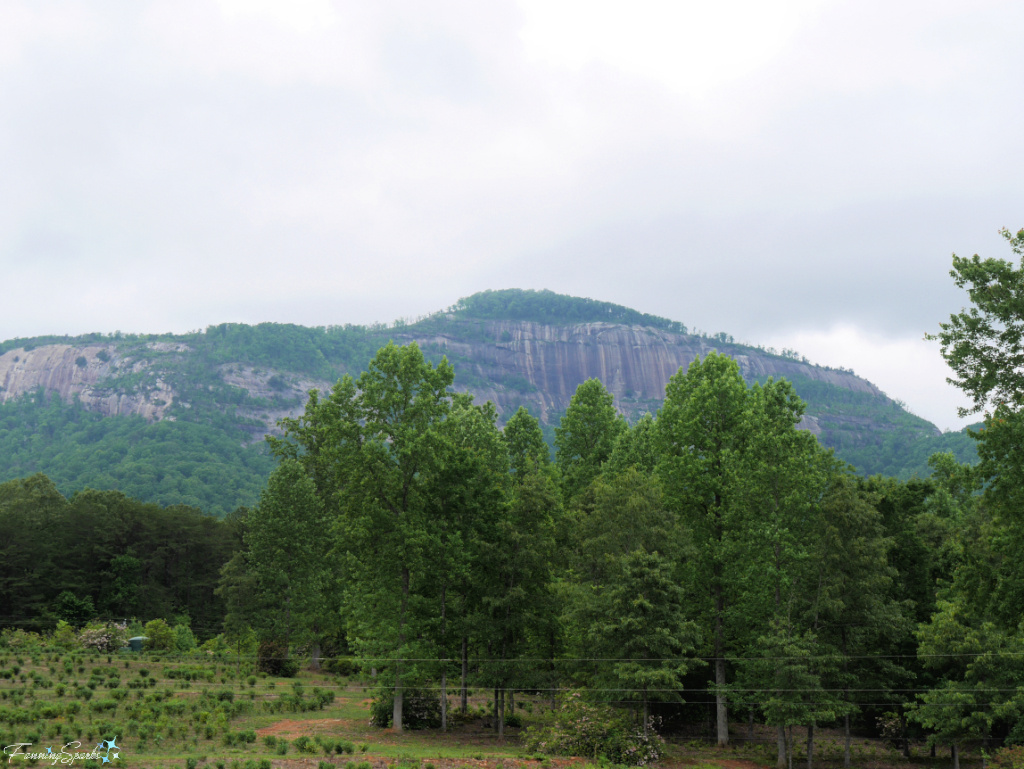 “Our climate offers the ideal location for growing premium, small-batch tea crafted with the best of both traditional and modern methods.” reports their website. Tea plants (Camellia sinensis) cover this hillside field at the Table Rock Tea farm.
“Our climate offers the ideal location for growing premium, small-batch tea crafted with the best of both traditional and modern methods.” reports their website. Tea plants (Camellia sinensis) cover this hillside field at the Table Rock Tea farm.
 Here’s another view of the tea plants with a mature hedgerow in the foreground. That hedgerow was instrumental to the farm’s beginnings as Lorch explains in a World Tea News article, “We wanted to do an edible hedgerow and decided to plant it with tea. Four hundred to 500 plants were needed for the hedge, and we thought, ‘That’s a lot of tea! Why don’t we just start a tea company?’ So, we did.”
Here’s another view of the tea plants with a mature hedgerow in the foreground. That hedgerow was instrumental to the farm’s beginnings as Lorch explains in a World Tea News article, “We wanted to do an edible hedgerow and decided to plant it with tea. Four hundred to 500 plants were needed for the hedge, and we thought, ‘That’s a lot of tea! Why don’t we just start a tea company?’ So, we did.”
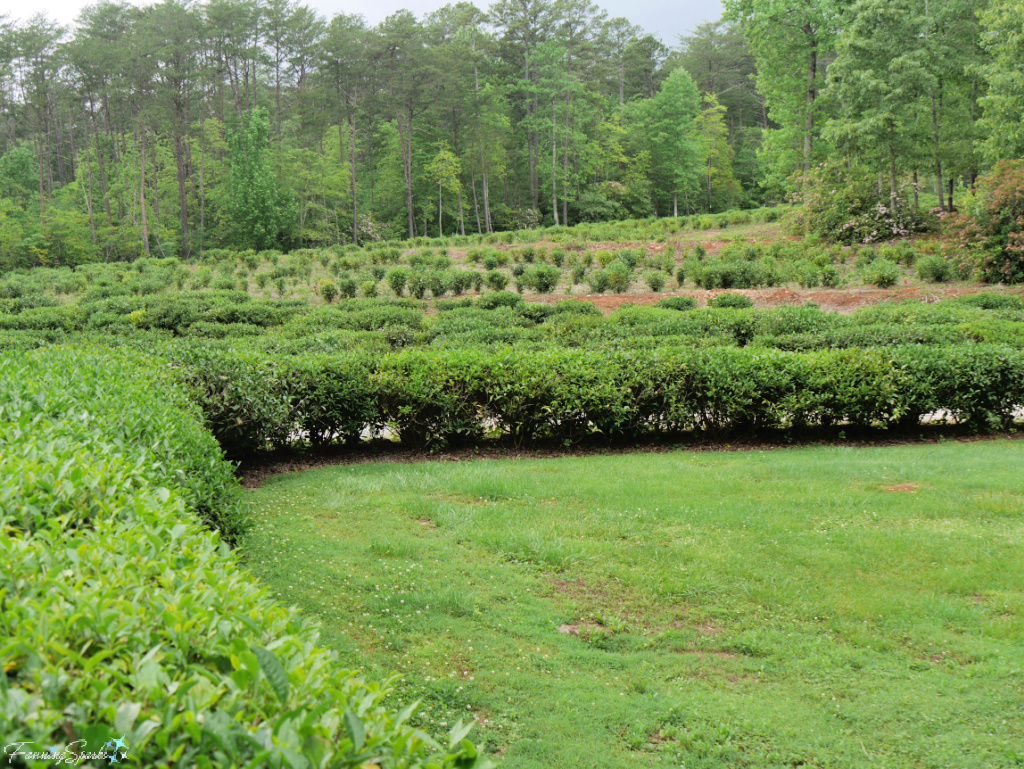 Our tour guide pointed out “two leaves and a bud” on a tea plant explaining only this tender, new growth is picked for tea.
Our tour guide pointed out “two leaves and a bud” on a tea plant explaining only this tender, new growth is picked for tea.
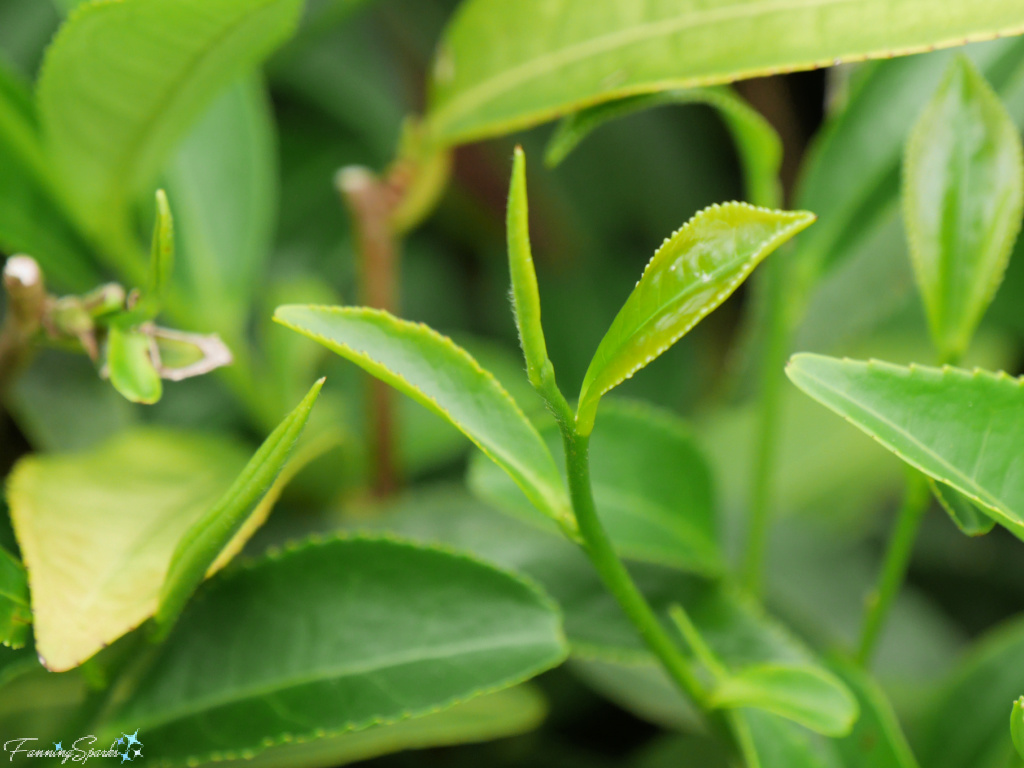 Our tour included a visit to the greenhouse.
Our tour included a visit to the greenhouse.
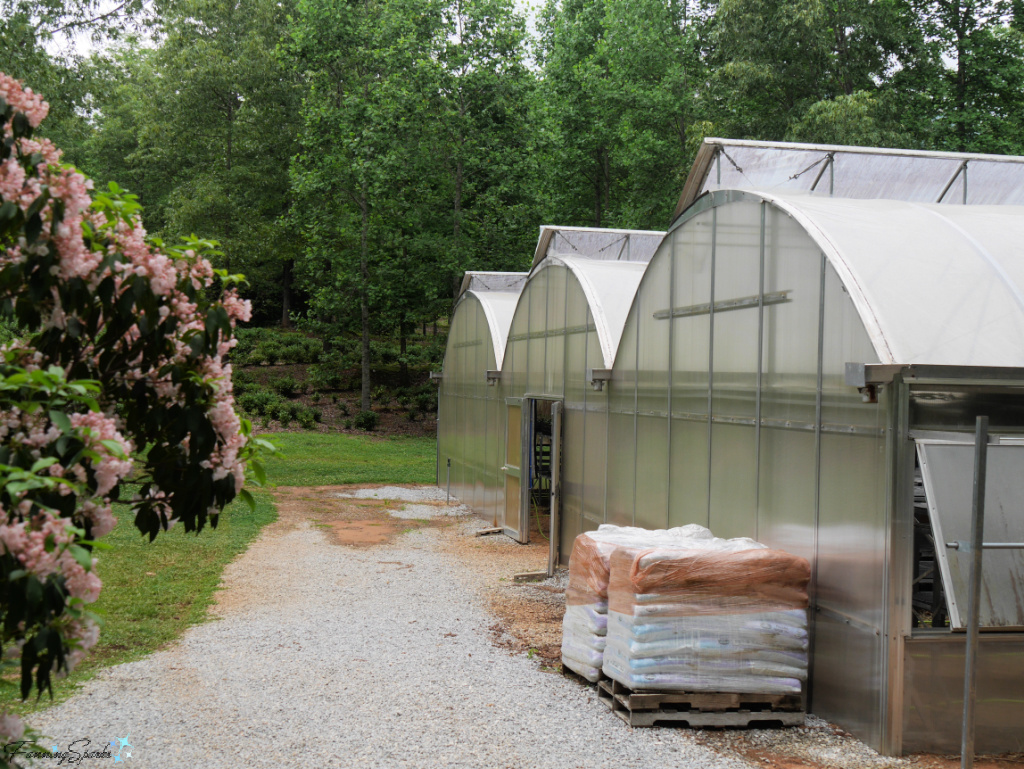 Table Rock Tea Company starts their tea plants from seed (shown bottom left) to ensure a strong tap root develops. Alternatively, tea plants can be started from cuttings but they produce a shallow network of roots instead of the long, strong tap root needed for the local soil conditions.
Table Rock Tea Company starts their tea plants from seed (shown bottom left) to ensure a strong tap root develops. Alternatively, tea plants can be started from cuttings but they produce a shallow network of roots instead of the long, strong tap root needed for the local soil conditions.
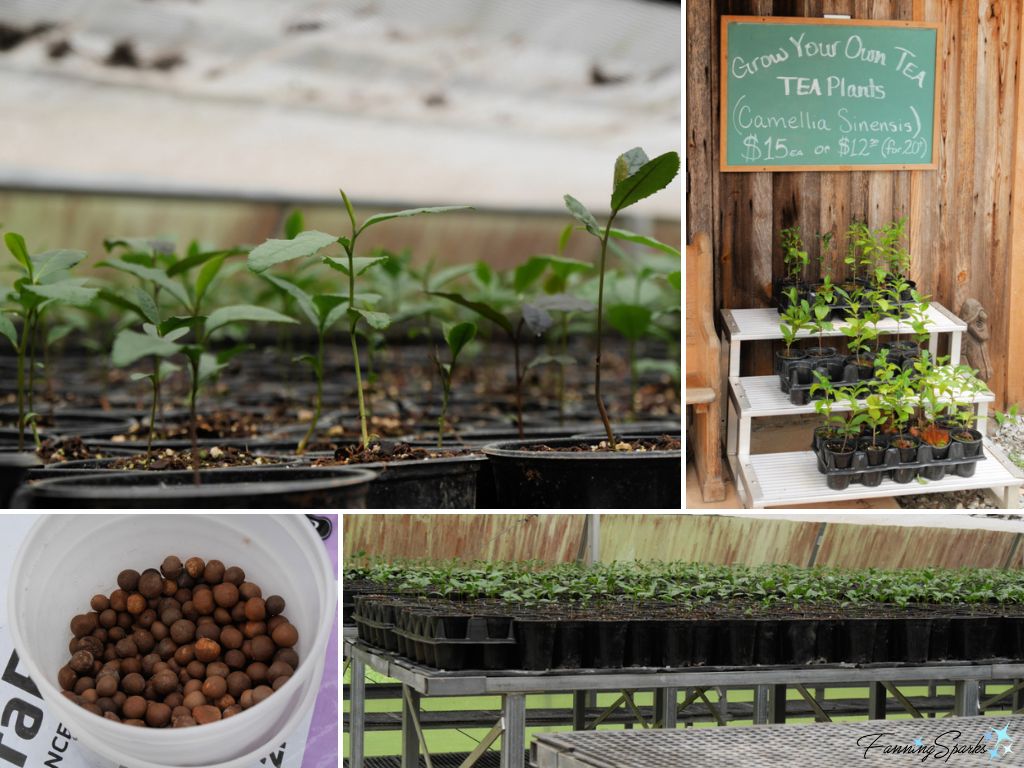 The tour concluded with an explanation of tea processing. The first step is to let the leaves wither. Traditionally, bamboo withering racks, like those shown on the left below, were used to wither the tea leaves. The next step depends on the variety of tea being made. For instance, the withered leaves are dried to make green tea.
The tour concluded with an explanation of tea processing. The first step is to let the leaves wither. Traditionally, bamboo withering racks, like those shown on the left below, were used to wither the tea leaves. The next step depends on the variety of tea being made. For instance, the withered leaves are dried to make green tea.
Oolong and black tea require further processing—the withered leaves are oxidized by rolling, crushing and bruising in a tea rolling machine. A traditional tea rolling machine is shown on the right below. Of course, the tea company doesn’t actually use these machines, they use modern equipment for their processing.
The traditional tea processing equipment is from China and dates around the mid-1900s. It’s on display as part of the Real American Tea Museum which “features curated exhibits and artifacts to emphasize the production side of tea, particularly in America. The collection of old machinery and oddities shows off the often-unseen side of the industry.” reports Lorch.
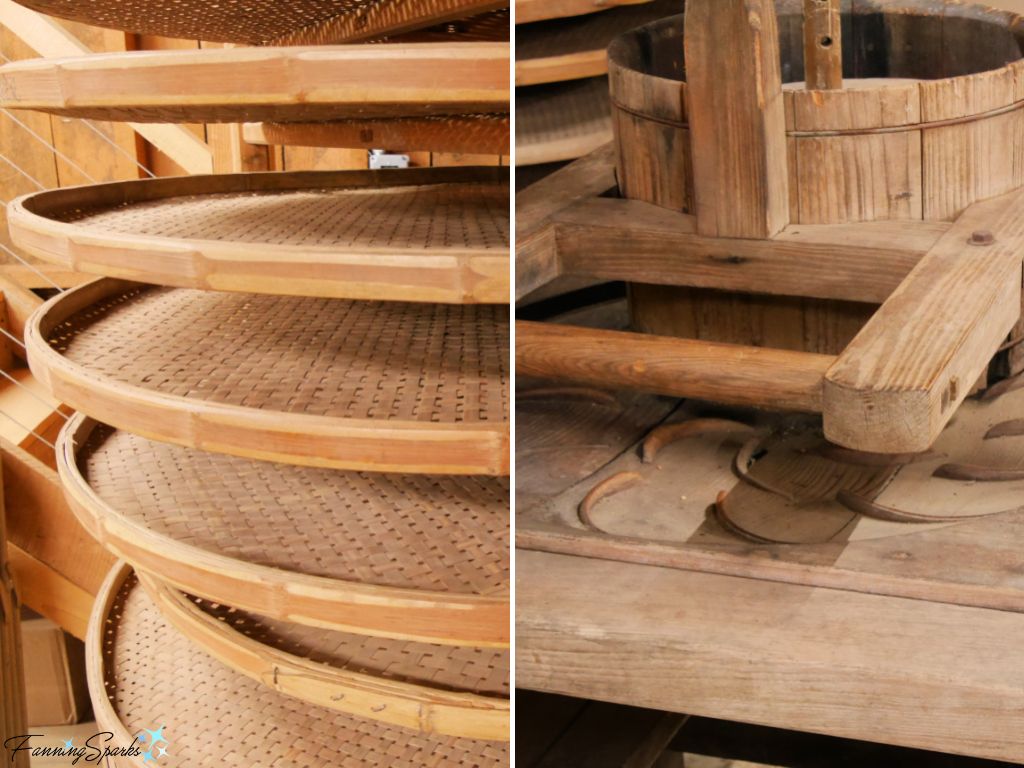
Mushroom Mountain
“Mushroom Mountain is a certified organic mushroom spawn laboratory and farm, located in Easley, SC.” states their Local Food Guide Listing on the Appalachian Grown website. “We carry over 100 different species of fungi, that are used in mushroom cultivation, for medicinal purposes, and in Mycoremediation. We teach mushroom cultivation workshops, hold regular farm tours that feature our mushroom trail, and are regulars at most local food, farming, and sustainable conferences. We also consult for mushroom cultivation.”
Here’s a sampling of Mushroom Mountain’s dried mushroom products as well one of the books they recommend—Mycelium Running by renown mushroom expert Paul Stamets.
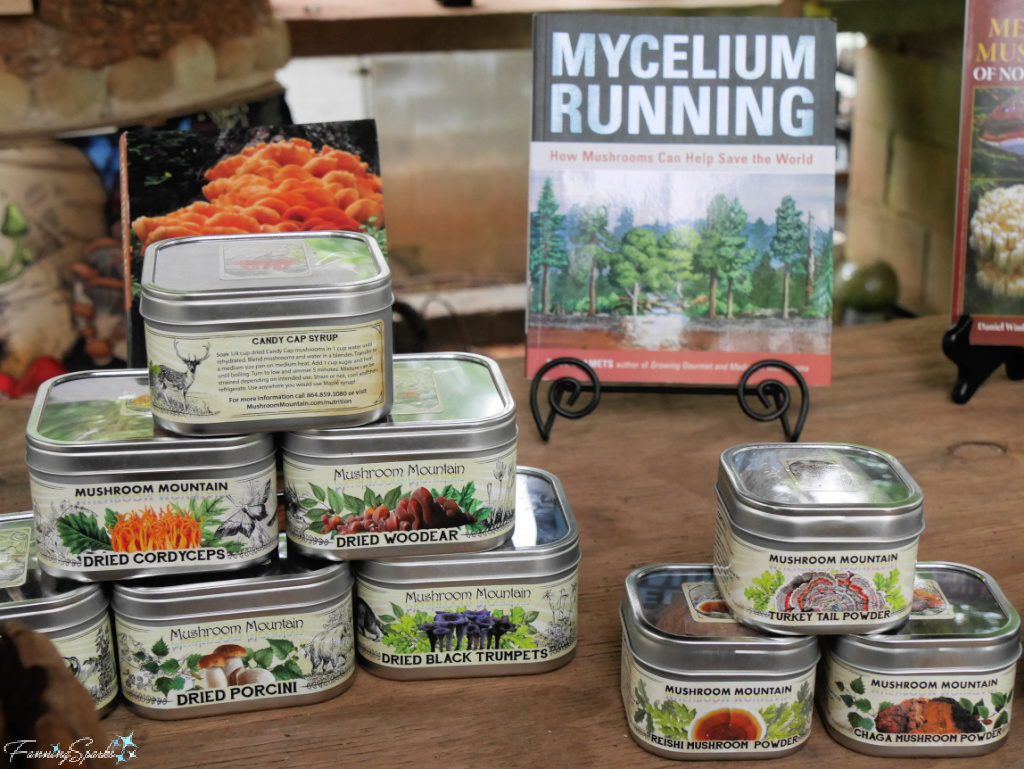 It’s obvious the folks at Mushroom Mountain take the sharing of knowledge seriously. As Olga Katic, owner of Mushroom Mountain, puts it “our role is to steward the natural world and achieve harmony with nature through fungi by sharing our knowledge and expertise.” Shown below is a wall mural used to help educate visitors about the life cycle of a mushroom.
It’s obvious the folks at Mushroom Mountain take the sharing of knowledge seriously. As Olga Katic, owner of Mushroom Mountain, puts it “our role is to steward the natural world and achieve harmony with nature through fungi by sharing our knowledge and expertise.” Shown below is a wall mural used to help educate visitors about the life cycle of a mushroom.
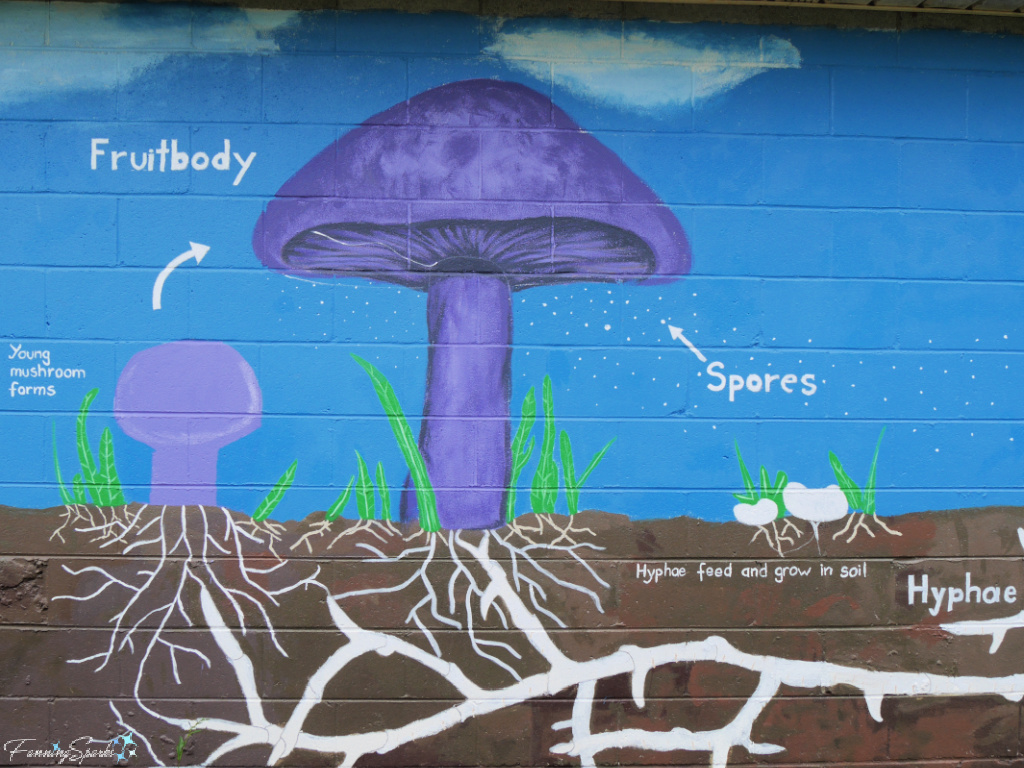 The mural is included in the farm tours Mushroom Mountain offers to visitors and growers. Participants in the Ag & Art Tour were invited to participate in a complimentary tour. I was astounded by the amount of information Billie Katic, our tour guide, was able to share in 90 minutes.
The mural is included in the farm tours Mushroom Mountain offers to visitors and growers. Participants in the Ag & Art Tour were invited to participate in a complimentary tour. I was astounded by the amount of information Billie Katic, our tour guide, was able to share in 90 minutes.
She explained how Mushroom Mountain starts mushroom cultures on agar plates and then moves them to sterilized grain jars to grow. If I understood correctly, when the mushroom culture has devoured all the grain, the spawn is introduced to sterilized sawdust or wood dowels. Mushroom Mountain sells pure cultures, plug and sawdust spawn. As noted on their website, “Sawdust spawn is versatile, affordable, and can be used for logs, stumps, wood chips, mulch, coffee grounds and pasteurized agricultural byproducts. … Plugs are the most basic way to grow mushrooms on logs. If you are just getting started growing mushrooms this will be the easiest spawn to handle and inoculate logs. This may also be best for you if you only want a few logs of any one species.”
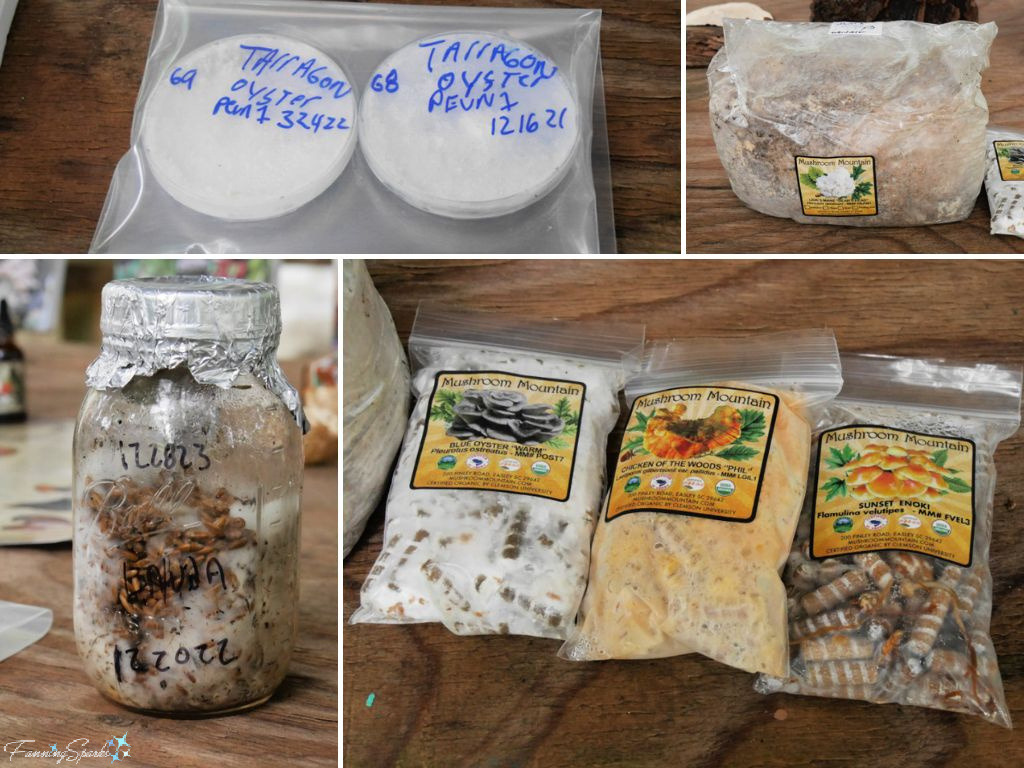 Here’s a peek into the laboratory where much of the mushroom culture work takes place.
Here’s a peek into the laboratory where much of the mushroom culture work takes place.
 We also visited a small greenhouse where we were able to study a few fruiting mushrooms including this striking Flamingo Oyster Mushroom (Pleurotus salmoneo-stramineus) and…
We also visited a small greenhouse where we were able to study a few fruiting mushrooms including this striking Flamingo Oyster Mushroom (Pleurotus salmoneo-stramineus) and…
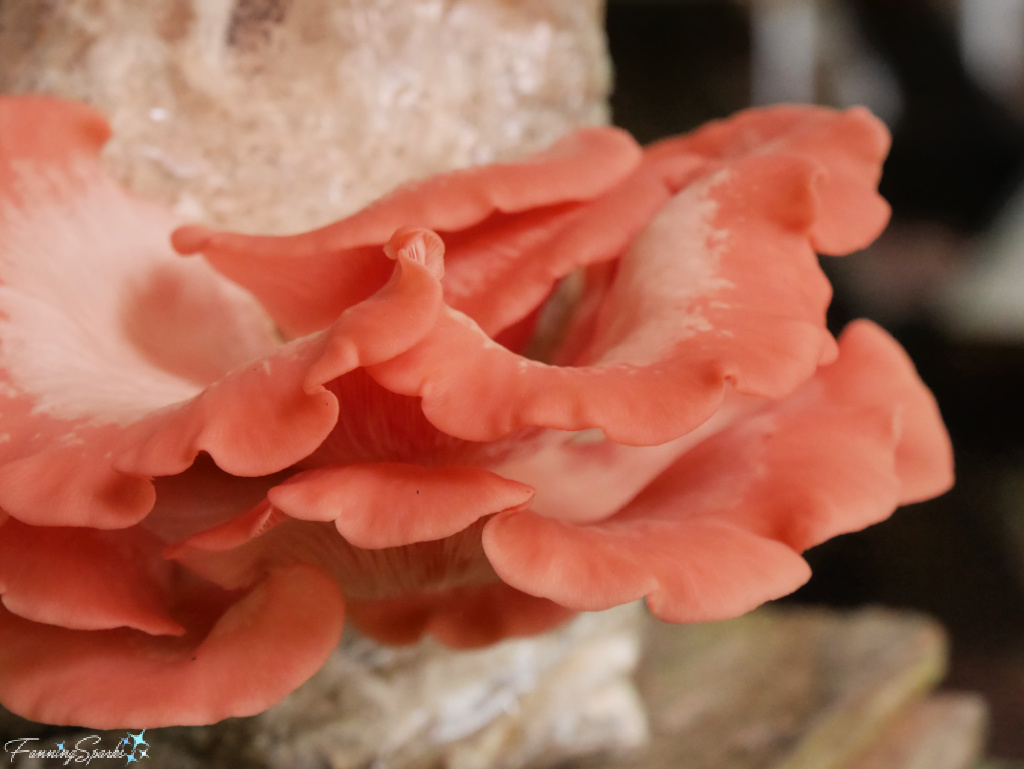
… this Golden Oyster Mushroom (Pleurotus citrinopileatus).
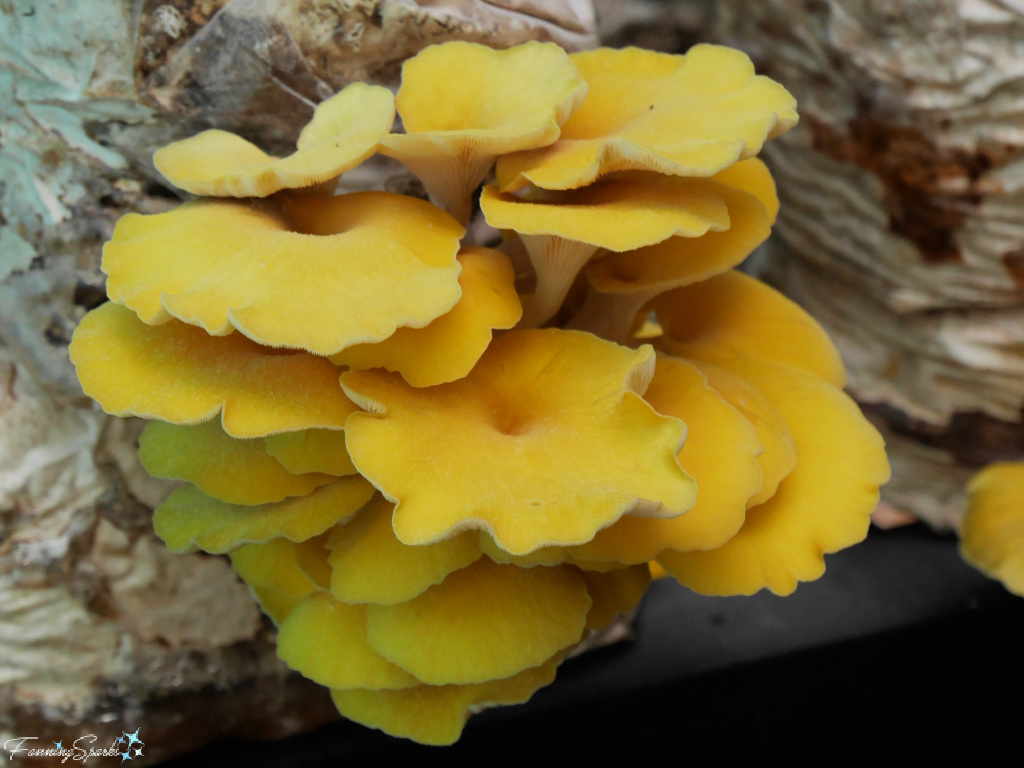
Mushroom Mountain offers training for wild mushroom foraging. The Wild Mushroom Food Safety Certification courses meet the criteria required by Health Departments covering topics such as mushroom identification, food safety, record keeping and traceability. Shown below is a chart labeled “Is It Turkey Tail?” which is used to help educate students on the identification of the Turkey Tail mushroom.
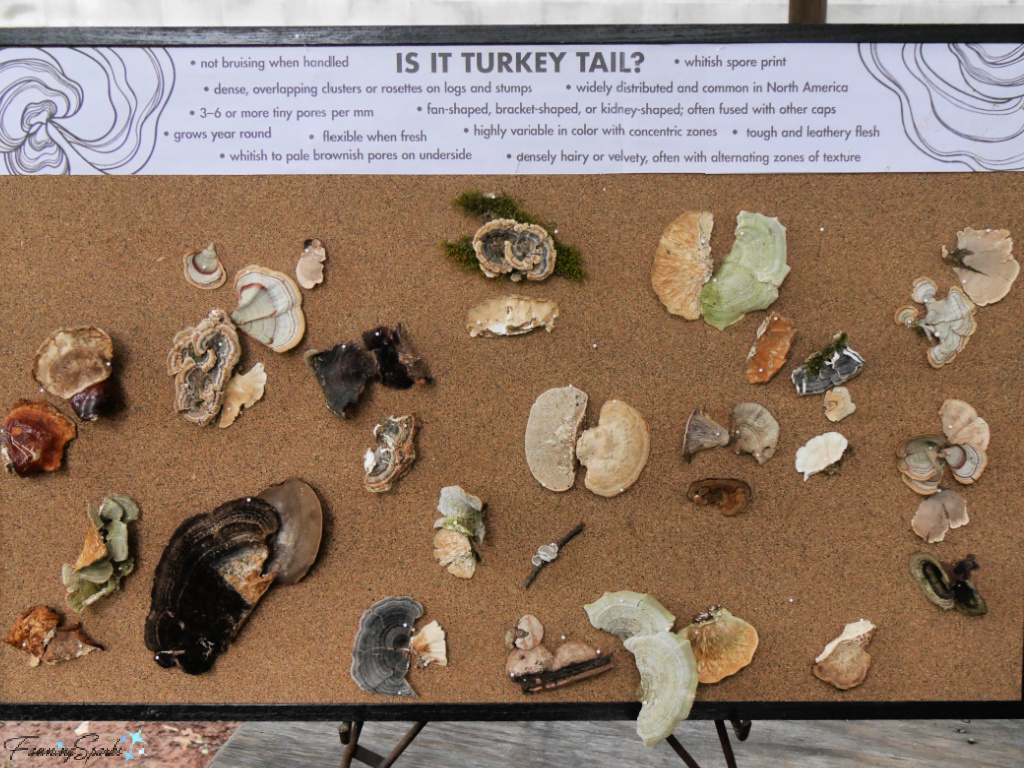 The Mushroom Trail is another outstanding educational aid. It may well be, as the Mushroom Mountain website proudly states “the best mushroom trail on the planet, dedicating outdoor space for fruiting displays of mushrooms and other fungi organized by genera and specific groups for visitors to examine, photograph, study, and admire.”
The Mushroom Trail is another outstanding educational aid. It may well be, as the Mushroom Mountain website proudly states “the best mushroom trail on the planet, dedicating outdoor space for fruiting displays of mushrooms and other fungi organized by genera and specific groups for visitors to examine, photograph, study, and admire.”
In each display area, an informative sign provides the relevant data for the featured variety including Latin and common names, edibility rating, description, fruiting seasons, gills, spore print, fruiting substrates, cultivation, Mycoremediation, and other uses. Here’s a shiitake mushroom with a glimpse of its informational sign.
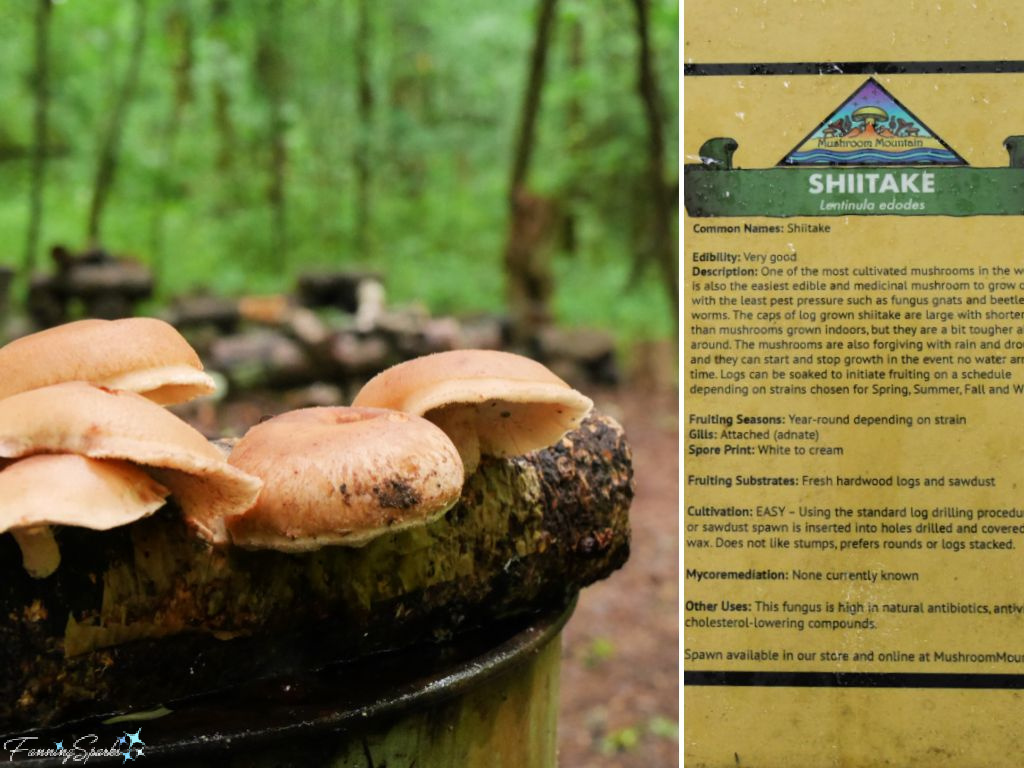 The Mushroom Trail is also a great way to observe various ways to grow mushrooms. Here’s a look at one of the exhibits with stacked inoculated logs. Parchment fungi is visible on the end of one of the logs.
The Mushroom Trail is also a great way to observe various ways to grow mushrooms. Here’s a look at one of the exhibits with stacked inoculated logs. Parchment fungi is visible on the end of one of the logs.
 On the more light-hearted side of things, fun touches like these giant, hand-crafted mushrooms are sprinkled throughout the Mushroom Mountain property.
On the more light-hearted side of things, fun touches like these giant, hand-crafted mushrooms are sprinkled throughout the Mushroom Mountain property.
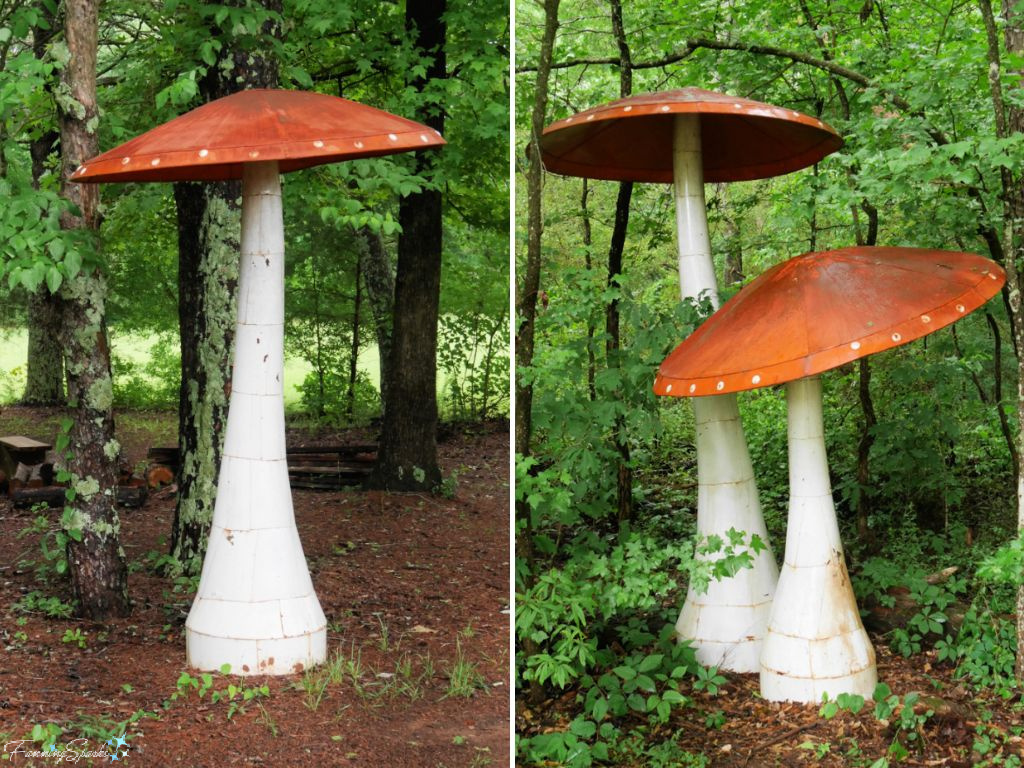
The Happy Berry
The Happy Berry is a U-Pick farm focused on small fruit including blackberries, blueberries, muscadines, grapes and figs. It was too early for this year’s crop but last year’s harvest was on offer in the form of jams and jellies.
 The Happy Berry is located in Six Mile, South Carolina on the eastern shore of Lake Keowee where the land formations nurture an ideal micro-climate. Owner Walker Miller led walking tours through the farm and regaled us with stories of the region’s past and the farm’s history. Many of the farm’s hillsides are covered in lush blueberry bushes.
The Happy Berry is located in Six Mile, South Carolina on the eastern shore of Lake Keowee where the land formations nurture an ideal micro-climate. Owner Walker Miller led walking tours through the farm and regaled us with stories of the region’s past and the farm’s history. Many of the farm’s hillsides are covered in lush blueberry bushes.
 Miller generously shared several best practices including, for example, how to prune blueberries. The key, he explained, is to remove ⅕ of the shrub’s stems every year. Select the oldest and biggest stems and cut them as close to the ground as possible.
Miller generously shared several best practices including, for example, how to prune blueberries. The key, he explained, is to remove ⅕ of the shrub’s stems every year. Select the oldest and biggest stems and cut them as close to the ground as possible.
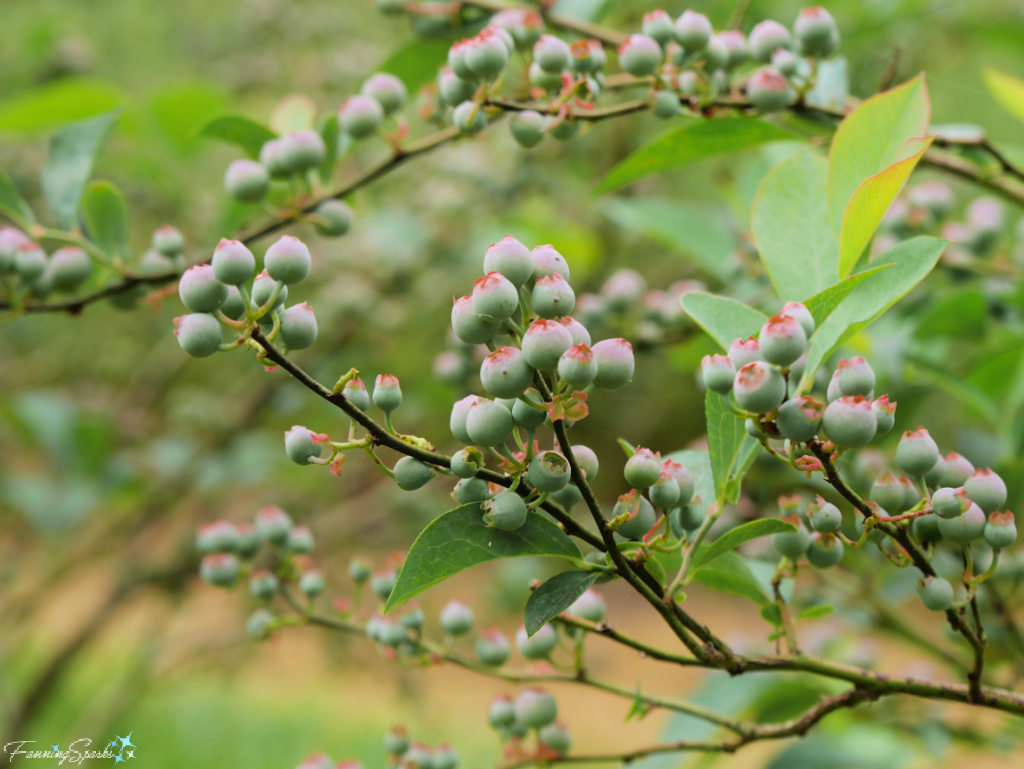 Blackberries are another favorite crop at The Happy Berry. Unfortunately, they are also a favorite of the local deer population who will eat the entire plant—especially the thornless varieties.
Blackberries are another favorite crop at The Happy Berry. Unfortunately, they are also a favorite of the local deer population who will eat the entire plant—especially the thornless varieties.
 We also saw large expanses of hillside covered with newly planted grape vines. Miller explained he’s in the midst of replacing the seeded grapes he grew previously with new seedless varieties. The blue plastic tubes, visible in the photo below, protect the young vines.
We also saw large expanses of hillside covered with newly planted grape vines. Miller explained he’s in the midst of replacing the seeded grapes he grew previously with new seedless varieties. The blue plastic tubes, visible in the photo below, protect the young vines.
 I was surprised to learn The Happy Berry also grows a sizable patch of Pussy Willows (Salix discolor). Pussy willow twigs are a popular choice for flower arrangements. The Happy Berry folks sell them at local farmers markets in the spring.
I was surprised to learn The Happy Berry also grows a sizable patch of Pussy Willows (Salix discolor). Pussy willow twigs are a popular choice for flower arrangements. The Happy Berry folks sell them at local farmers markets in the spring.
 Another unusual crop grown at The Happy Berry is Izu, Fuyu and Kaki persimmons. The fruit of the persimmon tree is said to resemble an orange tomato when it’s ripe. They can be eaten raw like an apple, added to salads, baked in tarts or, as other folks on my tour attested, used to make wine and beer.
Another unusual crop grown at The Happy Berry is Izu, Fuyu and Kaki persimmons. The fruit of the persimmon tree is said to resemble an orange tomato when it’s ripe. They can be eaten raw like an apple, added to salads, baked in tarts or, as other folks on my tour attested, used to make wine and beer.
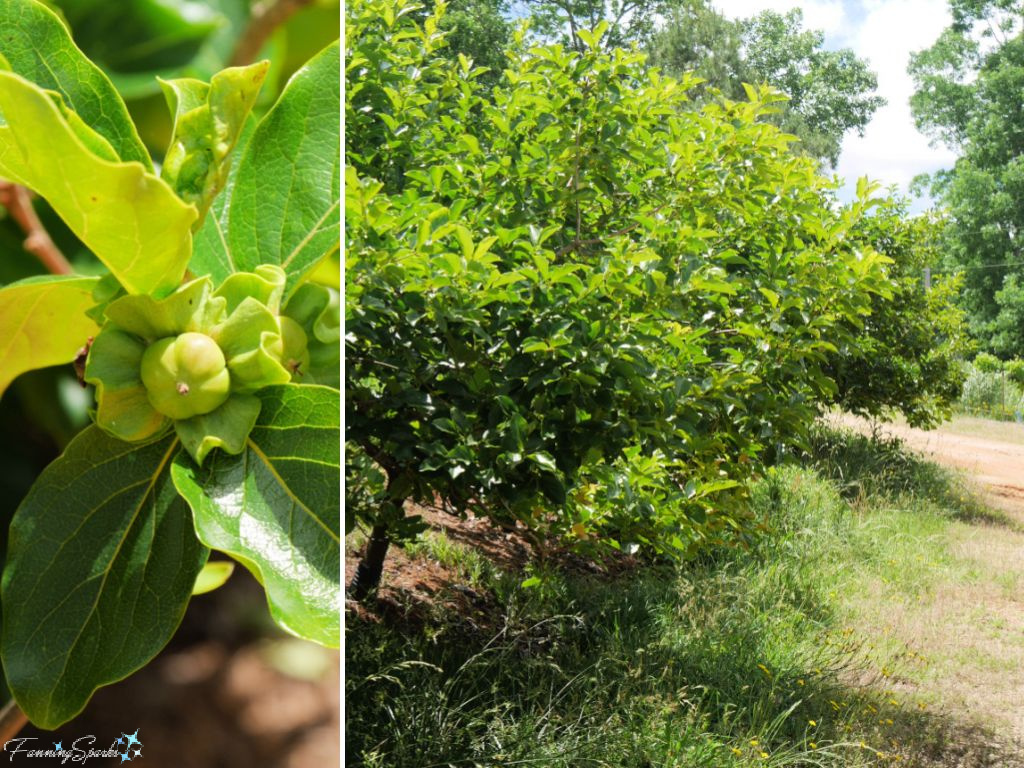 I thoroughly enjoyed all three of these farm visits and guided tours. The tours were well organized, the itineraries were thoughtfully planned and the information was clearly presented. All of the guides were knowledgeable and entertaining and they generously shared their expertise with their visitors. Many thanks to all the organizers, owners, hosts, tour guides and facilitators for a wonderful agritourism experience!
I thoroughly enjoyed all three of these farm visits and guided tours. The tours were well organized, the itineraries were thoughtfully planned and the information was clearly presented. All of the guides were knowledgeable and entertaining and they generously shared their expertise with their visitors. Many thanks to all the organizers, owners, hosts, tour guides and facilitators for a wonderful agritourism experience!
Guided tours, however, are only the beginning in learning about the three venues featured in today’s blog post. All three farms offer a variety of one-of-a-kind immersive events with occasional opportunities to volunteer for free hands-on activities.
Table Rock Tea Company often welcomes volunteers to assist with transplanting seedlings or picking tea. Mushroom Mountain hosts an Annual MycoBlitz celebration, a free event where participants learn about growing mushrooms while assisting with various activities such as log plugging, mushroom bed-making and trail cleaning. The Happy Berry invites volunteers to help with activities around the farm such as planting, pruning and clearing land. They even have defined volunteer positions for bee and bird management.
To make the most of these and similar immersive agritourism opportunities you’ll want to plan in advance and be open to the unexpected. Some events may be seasonal or weather-dependent. Some may require an extended commitment. Most events will have limited capacity and will require advance notice. This year’s Mushroom Mountain MycoBlitz, for instance, is already fully booked—5 months prior to the event.
More Info
The IMARC Group market research study, “Agritourism Market: Global Industry Trends, Share, Size, Growth, Opportunity and Forecast 2024-2032” , offers insight into the global agritourism market.
See the Ag + Art Tour in South Carolina website or Instagram page to learn more about this annual event.
To learn more about the farms featured in today’s blog post see:
. Table Rock Tea Company website or Instagram page. You may also want to read the World Tea News article: Table Rock Tea Company Strives to Make a Positive and Lasting Impact as U.S. Tea Growers by Aaron Kiel.
. Mushroom Mountain website or Instagram page. You may also want to read the World Mushroom Society article: Interview with Olga Katic, Founder of Mushroom Mountain by Jason Vergara. The Appalachian Grown website includes the ASAP (Appalachian Sustainable Agriculture Project) Local Food Guide Listing which can be found here.
. The Happy Berry website or Instagram page.
To learn more about the astonishing world of mushrooms and their potential benefits, check out relevant studies on:
. The National Center for Biotechnology Information website which “advances science and health by providing access to biomedical and genomic information”.
. MushroomReferences.Com website which is “A Curated List of References Relevant to Physicians, Scientists, and the Intellectually Curious” sponsored by Paul Stamets.
Farm visits and other agritourism activities are a recurring theme here on the FanningSparks blog. You may also be interested in the following FanningSparks’ blog posts:
. An Alpaca Photo Shoot at Meadow Brook Stables in Alton, Nova Scotia.
. Stop and Smell the Lavender, a visit to the Red Oak Lavender Farm near the city of Dahlonega, Georgia.
. In the Sunflower Field, shutter therapy at Farmview Market’s U-Pick Sunflowers in Madison, Georgia.
. A Peach of a Day, the story of picking peaches at Southern Belle Farm in Georgia.
. Crowing and Clucking in the Barnyard, shutter therapy at Hundred Acre Farm in Madison, Georgia.
. A Visit to Mabel Murple’s, a delightful farm surprise in River John, Nova Scotia hosted by award-winning, children’s book author Sheree Fitch.
Today’s Takeaways
1. Agritourism is the business of engaging, entertaining and educating visitors on farms and in other agricultural settings.
2. The annual Ag + Art Tour in South Carolina is a great example of a successful agritourism event.
3. Consider visiting a local farm for an immersive travel experience.


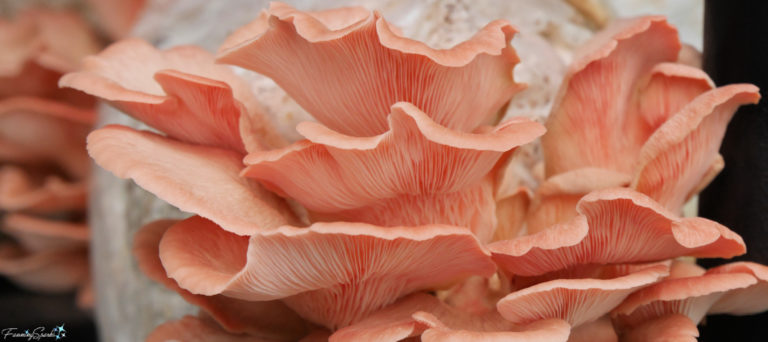


2 Comments
@Marian, Figuring out what’s available is often the biggest challenge. But so worth the effort! Peg
Love your telling of such informative tours.
Now… where should I go to learn…?